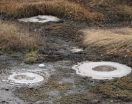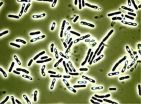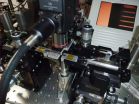Story tips from the Department of Energy's Oak Ridge National Laboratory, April 2015
2015-04-01
(Press-News.org) ENVIRONMENT - Invertebrates' role in bioaccumulation ...
By studying fish and invertebrates in a creek with known mercury contamination, researchers are gaining a better understanding of the relationship between the toxin in the stream and bioaccumulation in organisms. While mercury concentrations in East Fork Poplar Creek in Oak Ridge, Tenn., have decreased significantly over the last 30 years, levels in tissue from fish have remained the same or increased. To understand why, a team led by Monica Poteat of Oak Ridge National Laboratory is examining the intricacies of the food chain and the biodiversity of the stream at locations about 10 kilometers apart. "Downstream sites have more complex community structures, which can lead to greater transfer of mercury to fish through the food chain," said Poteat, who presented this work at the Carolinas Society of Environmental Toxicology and Chemistry Annual Meeting. [Contact: Ron Walli, (865) 576-0226; wallira@ornl.gov]
ENERGY - School retrofit paying dividends ...
A ground source heat pump installed at rural Cedarville High School in Arkansas through the American Recovery and Reinvestment Act has reduced energy use by 53 percent and carbon dioxide emissions by 52 percent, according to an Oak Ridge National Laboratory report. ORNL researchers Xiaobing Liu and Mini Malhotra also noted that the new system has dramatically improved air quality while providing cooling to areas that previously had none. Energy savings will result in a 15-year payback of the $1.6 million ARRA grant, Liu said, adding that further energy savings can be realized with improved control of the pumps that circulate water. Results are to be presented this summer at the American Society of Heating, Refrigerating, and Air-Conditioning Engineers (https://www.ashrae.org) annual conference in Atlanta. [Contact: Ron Walli, (865) 576-0226; wallira@ornl.gov]
BATTERIES - Simulation software aids design ...
Designers of safe high-performance batteries for electric vehicles are getting a hand with a new computational toolset created by a team led by Sreekanth Pannala and John Turner of Oak Ridge National Laboratory. The software simulates key battery performance indicators, including charge and thermal transport, electrochemical reactions and battery mechanical stresses. This capability will accelerate the research and design process for academic, national laboratory and industry users. "We developed integrated tools so that one doesn't have to employ different performance models for different applications," Pannala said. The software, known as Virtual Integrated Battery Environment, was developed as part of the Computer-Aided Engineering for Batteries program and is available for download at http://www.batterysim.org. [Contact: Ron Walli, (865) 576-0226; wallira@ornl.gov]
ENERGY - Microbes vs. buildings ...
While reflective roofs can save energy and money for homeowners, microbial communities and the biofilms they create can eat away at the effectiveness and savings. A study led by Mengdawn Cheng and Andre Desjarlais of Oak Ridge National Laboratory found that the amount of energy absorbed instead of reflected doubles from its initial value in slightly more than a month. The culprits are strains of fungus, algae and bacteria that attach to surfaces and grow, causing soiling of the roof surface and the loss of reflectivity. Researchers who performed genetic sequencing to pinpoint the strains of bacteria set up multiple test sites in Florida, Pennsylvania and Tennessee. While bacterial distributions across the three states were similar, fungal distributions varied by region with Tennessee having the least fungus. Ultimately, Cheng expects this and follow-on research to help in the development, testing and compliance of Energy Star cool roofs. [Contact: Ron Walli, (865) 576-0226; wallira@ornl.gov]
COMPUTING - Reconstructing neurons ...
Supercomputing resources at Oak Ridge National Laboratory will support a new initiative designed to advance how scientists digitally reconstruct and analyze individual neurons in the human brain. Led by the Allen Institute for Brain Science, the BigNeuron project aims to create a common platform for analyzing the 3-D structure of neurons. "We have to start from the images of neurons and figure out where all the 'wires' are and how they are connected, and this process requires massive computational power," said ORNL's Arvind Ramanathan. ORNL supercomputers will be used to run, test and evaluate the algorithms that the Allen Institute and a worldwide consortium are developing as part of the BigNeuron project. [Contact: Morgan McCorkle, (865) 574-7308; mccorkleml@ornl.gov]
INFORMATION:
ELSE PRESS RELEASES FROM THIS DATE:
2015-04-01
WASHINGTON, DC, April 1, 2015 -- America's welfare state is quietly evolving from needs-based to an employment-based safety net that rewards working families and fuels dreams of a better life, indicates a new study led by a Michigan State University (MSU) scholar.
The major reason: the little-known Earned Income Tax Credit (EITC), a $65 billion federal tax-relief program for poor, working families. The program has been expanded dramatically during the past 25 years, while cash welfare has been sharply curtailed.
Reporting in the April issue of the American Sociological ...
2015-04-01
WASHINGTON, March 30, 2015 -- Last year, Reactions shook up the comedy world with a video featuring nothing but chemistry jokes. After overwhelming public acclaim, we're back for this April Fools' Day with round two, featuring a number of fan submissions. If you're looking for a laugh, or maybe a groan or two, check out the video here: https://youtu.be/QbxBsD_tDQw.
Subscribe to the series at http://bit.ly/ACSReactions, and follow us on Twitter @ACSreactions to be the first to see our latest videos.
INFORMATION:
The American Chemical Society is a nonprofit organization ...
2015-04-01
Irvine, Calif., April 1, 2015 -- A pouchlike structure inside the heart's left atrial chamber in some people may explain strokes that otherwise lack an identifiable cause, according to UC Irvine School of Medicine researchers.
Dr. Mark Fisher, a professor of neurology and pathology & laboratory medicine, and colleagues evaluated 75 stroke patients at UC Irvine Medical Center to learn whether this left atrial septal pouch could be a potent source of stroke-causing blood clots.
Of the 23 patients who had experienced a stroke of undetermined origin (a "cryptogenic" stroke), ...
2015-04-01
Jena (Germany) The "Villa trans lacum" at the eastern shore of the Laacher See (lake) in the volcanic part of the Eifel - a rural landscape in Germany - was a highly dangerous place. In the 19th century the Jesuit order bought the abbey Maria Laach and built a villa at the shore of the lake. This is where the friars congregated to pray far away from everyday life. But numerous Jesuits paid with their lives for the religious beliefs in the villa. Between 1864 and 1888 17 of them died in the building - literally in their sleep.
"The monks possibly died of carbon dioxide ...
2015-04-01
This news release is available in German.
The Bacillus cereus bacteria is one of the potential causes of food poisoning. Indeed, a recent study in Analytical and Bioanalytical Chemistry shows that this versatile pathogen produces 19 different variants of a poison that causes nausea and vomiting in human beings. This variety could explain why some cases are relatively benign and others can result in death.
Across Europe, the number of food poisoning cases caused by the Bacillus species is on the rise. While unpleasant, infections resulting from B. cereus are usually ...
2015-04-01
Our opponents always seem to be one step ahead. Although pest controllers now have numerous chemical preparations available, allowing them to take action against unwanted insects, the species targeted are developing a resistance against the different active substances at a rapid pace. Often a single change in the organisms' genetic material is enough to do this. This means that scientists know more than 500 pests all over the world currently able to resist a total of 300 different insecticides. Many disease-transmitting mosquitoes defy any attempts to control them just ...
2015-04-01
The core circuits of quantum teleportation, which generate and detect quantum entanglement, have been successfully integrated into a photonic chip by an international team of scientists from the universities of Bristol, Tokyo, Southampton and NTT Device Technology Laboratories. These results pave the way to developing ultra-high-speed quantum computers and strengthening the security of communication.
Qubits (quantum bits) are sensitive quantum versions of today's computer 0's and 1's (bits) and are the foundation of quantum computers. Photons are particles of light and ...
2015-04-01
Penicillin has nearly eradicated rheumatic heart disease (RHD) in the United States. But 15 million people still suffer with the disease worldwide, and 1.4 million die each year, according to World Heart Federation.
Access to penicillin can prevent deaths from RHD. Researchers from Case Western Reserve University, Makerere University and the Uganda Heart Institute at Mulago Hospital, a national referral hospital in Kampala, collaborated to learn about those obstacles to receive the medication and find ways to overcome them.
The researchers heard from some Ugandans ...
2015-04-01
The media is littered with celebrity trainers, bakers, nutritionists, even gardeners. But, one profession is always missing from the roster - the celebrity accountant. The reason is most likely due to the negative stereotypes propagated for centuries. However, this is no bad thing, according to researchers in Australia who suggest in the International Journal of Critical Accounting, that stock characters entrenched in popular culture provide professional stability.
Frances Miley of the University of New South Wales and Andrew Read of the University of Canberra, Australia, ...
2015-04-01
Damage to neural tissue is typically permanent and causes lasting disability in patients, but a new approach has recently been discovered that holds incredible potential to reconstruct neural tissue at high resolution in three dimensions. Research recently published in the Journal of Neural Engineering demonstrated a method for embedding scaffolding of patterned nanofibers within three-dimensional (3D) hydrogel structures, and it was shown that neurite outgrowth from neurons in the hydrogel followed the nanofiber scaffolding by tracking directly along the nanofibers, particularly ...
LAST 30 PRESS RELEASES:
[Press-News.org] Story tips from the Department of Energy's Oak Ridge National Laboratory, April 2015




